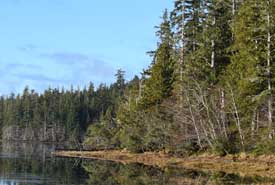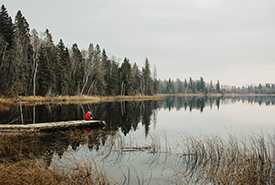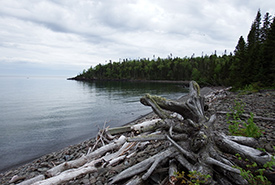Traditional Ecological Knowledge leads to better conservation

Gámdas Tlagée (Photo by Haida Laas-Graham Richard)
Incorporating Traditional Ecological Knowledge (TEK) when developing land and water conservation strategies is critical to help counteract climate change in Canada. Collaboration between western-based scientists and Indigenous TEK keepers is not only vital environmentally, but also as we move forward toward nation-to-nation reconciliation on Turtle Island.
The deeply spiritual connections between Indigenous Peoples and the lands on which they have lived for millennia can help provide scientific context to non-Indigenous people. This connection is integral to my identity as a Haudenosaunee woman on Turtle Island and as a storyteller. I find myself and my culture in the land and the water, and it is my duty to Mother Earth to do what I can to share how we can better protect it.
Here at the Nature Conservancy of Canada (NCC), collaboration with Indigenous Peoples is integral to the work we do to help protect landscapes across the country. As the staff writer at NCC, I use my voice as an Indigenous person to inform and educate people about the importance of TEK and the work we do.
Related blog posts
As climate change progresses, there has never been a more important time for conservation. To achieve the best results in protecting Mother Earth, we need to come together and learn from one another.
Over the past 15 years, NCC has developed several partnerships with Indigenous Peoples across Canada. NCC aims to sustain and build upon these successful relationships, as well as find opportunities to enhance our engagement as a strategic ally in support of Indigenous-led conservation initiatives. NCC is currently working with Indigenous Peoples across Canada on a variety of conservation projects across the country.

Treaty 4 territory, Qu'Appelle Valley, SK (Photo by Dane Roy)
In Ontario, NCC has a strong relationship with members of the Chippewas of Nawash Unceded First Nation and Saugeen First Nation of the Saugeen Ojibway Nation (SON). The work NCC does along the Saugeen Bruce Peninsula is woven with Traditional Knowledge from these Indigenous groups. Together, NCC and SON have created an inventory of species at risk, culturally significant species, medicinal plants and invasive species to better assess how to conserve these lands according to Indigenous teachings and land-based skills.
SON traditional lands span roughly 12,197 hectares (30,139 acres) of the Saugeen Bruce Peninsula. NCC owns and manages 3,134 hectares (7,744 acres) of land in this area, the majority of which are in proximity to the roughly 800-hectare (1,976-acre) stretch of hunting grounds used by members of the SON.
NCC is engaged with the SON in many different ways, including the use of these areas for both traditional and conservation purposes. The strength of the relationship between NCC and SON continues to grow and flourish in the shared land. Through protecting areas of securement, the stewardship of lands, inventorying of cultural resources and land management, training and employment, NCC is taking a step toward reconciliation.

Wilson Island, ON (Photo by NCC)
Working with Indigenous communities to access and protect cultural heritage resources on NCC-managed lands also provides an opportunity to acknowledge and respect the fact that people have lived on and used these lands for centuries. An improved understanding of the historical and cultural perspective of land use, occupancy and stewardship enhances western organizations such as NCC’s understanding of conservation lands in the broader landscape.
Sharing western knowledge and TEK is a step in the right direction for both nations and the land we stand on today. Organizations like NCC can learn from Indigenous resiliency and their long-lasting experiences on the land to make better-informed decisions on how best to protect the land. Through land and water protection, we can help lessen our impact on the Earth to slow down climate change.


